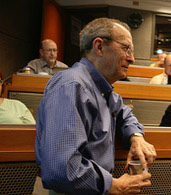Begin the practice of being still to give your brain some downtime. You'll see an overall energy increase, more results, and no overall loss in productivity.

Welcome, Jim Bruce

This edition of PD Commons introduces a familiar voice to new audiences. For the past 14 years, professor Jim Bruce has authored Tuesday Reading (TR), a weekly essay, distributed to thousands of readers, that focuses on leadership and the skills leaders need. Since he strongly believes that everyone can "lead from where you are," he writes about skills for everyone.
Ever the teacher, Jim has graciously agreed to select some of his best work from TR for republication in PD Commons. You can expect to see his work in this space several times over the coming year. Today's reading, "Be Still," follows this introduction to Jim.
Many leaders in higher education have benefited from Jim's guiding hand over the years. In 2016, Internet2 named him the first recipient of the William "Brit" Kirwan Mentorship Award, established to recognize individuals singled out by their peers for their work to develop IT leaders across higher education. In commenting on this award, colleagues spoke of Jim as "challenging individuals to become better, more effective leaders and fostering greater collaboration within universities, and between other institutions" and "making us not only better leaders, but better people" and credited him with having "mentored, guided, coached, cajoled, counseled, comforted, offered safe harbor, and provided reality checks for hundreds if not thousands of IT professionals in higher education" and "opened doors while opening my eyes to what was possible in ways that I can never possibly find words to thank him for."
Today, Bruce is senior fellow and executive coach at MOR Associates and retired professor of electrical engineering and vice president for information systems and CIO at the Massachusetts Institute of Technology. While CIO at MIT for 20 years, he was responsible for directing the evolution, integration, and effective use of computing and communications resources throughout MIT in support of planning, management, decision-making, and day-to-day operations. He also was an active leader, participant, or close observer for some of the most important educational, technical, and cultural developments that have shaped our digital world in the 21st century.
Welcome aboard, Professor Bruce!
—Bill Hogue, PD Commons Co-Editor
We have all heard this admonition to "be still" at various times in our lives. Usually, at least for me, when my mother or father or grandparents thought I was squirming too much in my chair at dinner or running around too much, knocking into adults, or playing too rambunctiously with other kids. It was a physical thing. In her essay, "Be Still and Be a Better Leader," Mary Jordan takes the phrase to another level—let our brains have quiet time and space to create.1
And, this is very hard. Our society is always on, obsessed with all manner of activity. We take the badge of "being busy" as something to be proud of. After all, if we are not doing something that looks and feels like work, we're not being productive. When, for example, was the last time you read or did something just for the fun of it?
Recent research at the University of Virginia and at Harvard has found that most subjects in their research study would rather be doing something, even something that hurt themselves, rather than doing nothing, or simply sitting alone with their thoughts, thinking, pondering, daydreaming.2 (The research protocol had them sit alone for periods of six to 15 minutes. The study's participants were drawn from a broad selection of backgrounds and ranged in age from 18 to 77.)
Jordan notes that David Rock, in his book Your Brain at Work [https://your-brain-at-work.com/],
describes what happens to our brains when they get over stimulated due to nonstop activity. That non-stop activity reduces the resources available to our prefrontal cortex (our thinking brain) functions such as memorizing, processing and decision making. The other problem with an over stimulated brain is we have a greater tendency to respond negatively to situations. We say and do things we later regret.3
Tony Schwartz, in a 2013 opinion piece in the New York Times, points out that "not getting enough sleep, or not having 'do nothing' time, was the highest predictor of on-the-job-burnout."4 He goes on to point out that it is unfortunate that most, dare I say all, of us see downtime as time wasted. More than 30% of employees eat lunch at their desks and 50% assume that they will work during part of their vacations. (Raise your hand if this describes you.) While rewards often accrue for such behavior, it doesn't mean that that these employees are the most productive.
In the 1950s, researchers William Dement and Nathaniel Kleitman discovered that we sleep in cycles about 90 minutes long, moving from light to deep sleep, cycle after cycle. (This is known as the basic-rest activity cycle, or BRAC.) Kleitman later discovered that this cycle is also present when we are awake, moving us from a state of alertness progressively into physiological fatigue approximately every 90 minutes. Our brain tells us to take a break then and we too often override that signal and charge ahead, having programmed ourselves via our calendar to do that.
Schwartz suggests that we organize our day to take advantage of this cycle working in 90-minute blocks with short breaks in between. He has three such blocks in his day and has demonstrated that he is far more productive than before. His company, The Energy Project, fully embodies these findings in the way people work and is a laboratory for the renewal principles it teaches. The company's core idea is that the energy employees bring to their jobs is far more important in terms of the value of their work than is the number of hours they work. They believe that by skillfully managing energy it is possible to get more done, in less time, more sustainably.
Tim Kreider, the author of We Learn Nothing, a collection of essays and cartoons, put it this way in a 2012 op-ed piece in the New York Times:
Idleness is not a vacation, an indulgence or a vice. It is as indispensable to the brain as vitamin D is to the body, and deprived of it we suffer a mental affliction as disfiguring as rickets. The space and quiet that idleness provides is a necessary condition for standing back from life and seeing it whole, for making unexpected connections and waiting for the wild summer lightning strikes of inspiration—it is, paradoxically necessary to getting any work done.5
So, I urge you to begin the practice of being still to give your brain some downtime. Divide your morning (and your afternoon) into two major chunks with a good-sized break in between and take a real nonworking lunch. If you do, I think that you'll see an overall energy increase, more results, and no overall loss in productivity. Let me know how it works out.
This blog post is reprinted from Jim Bruce, "Be Still," Tuesday Reading (blog), MOR Insight, March 31, 2015.
Notes
- Marty Jordan, "Be Still and Be a Better Leader" [http://mylinkage.com/blog/be-your-best-by-being-still/], Leadership Insights (blog), Linkage, March 18, 2015. ↩
- NBC29 WVIR Charlottesville, VA News Sports and Weather, "UVA Study: People Would Rather Shock Themselves than Sit & Think" [http://www.nbc29.com/story/25994609/uva-study-people-would-rather-shock-themselves-than-sit-think], updated July 25, 2014. ↩
- Jordan, "Be Still." ↩
- Tony Schwartz, "Relax! You'll Be More Productive," Sunday Review, New York Times, February 9, 2013. ↩
- Tim Kreider, The 'Busy' Trap, Opinion Pages, New York Times, June 30, 2012. ↩
Jim Bruce is Senior Fellow and Executive Coach at MOR Associates and retired Professor of Electrical Engineering and Vice President for Information Systems and CIO at the Massachusetts Institute of Technology.
© 2018 Jim Bruce
